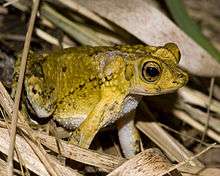Peltophryne
Peltophryne is a genus of true toads in the family Bufonidae,[1][2][3] from the Greater Antilles (Cuba, Isla de Juventud, Hispaniola, Puerto Rico).[1] With ten endemic species, Cuba hosts the highest diversity. Hispaniola has three endemics and Puerto Rico and the Virgin Islands combined has one.[4]
| Peltophryne | |
|---|---|
 | |
| Peltophryne lemur | |
| Scientific classification | |
| Kingdom: | Animalia |
| Phylum: | Chordata |
| Class: | Amphibia |
| Order: | Anura |
| Family: | Bufonidae |
| Genus: | Peltophryne Fitzinger, 1843 |
| Type species | |
| Bufo peltocephalus Tschudi, 1838 | |
| Species | |
|
See text | |
Description
Peltophryne range is size from the relatively small Peltophryne cataulaciceps with a snout–vent length (SVL) of 30 mm (1.2 in) to the large Peltophryne peltocephala with SVL of 170 mm (6.7 in). The skull is as long as wide and contains some unique osteological features (thickened dermal tissue covering the snout and usually ossified into a pair of rostral bones, and squamosal-maxillary articulation). These are considered to be derived characters that set these toads apart from other bufonids.[5]
Taxonomy
The genus was erected by Leopold Fitzinger in 1843, but placed in synonymy with Bufo by Albert Günther in 1859.[1] Subsequent work has considered Peltophryne either as a valid genus, a subgenus, or a synonym of Bufo. At present, treating Peltophryne as a valid genus has largely been accepted based on both morphological characters and genetic evidence,[1][2][3][6] but treating it as a subgenus of Bufo still has a small following.[1]
Species
There are 14 species in this genus:[1][2]
- Peltophryne armata Landestoy T., Turner, Marion, and Hedges, 2018
- Peltophryne cataulaciceps (Schwartz, 1959)
- Peltophryne dunni (Barbour, 1926)
- Peltophryne empusa Cope, 1862
- Peltophryne florentinoi (Moreno and Rivalta, 2007)
- Peltophryne fluviatica (Schwartz, 1972)
- Peltophryne fustiger (Schwartz, 1960)
- Peltophryne guentheri (Cochran, 1941)
- Peltophryne gundlachi (Ruibal, 1959)
- Peltophryne lemur Cope, 1869
- Peltophryne longinasus (Stejneger, 1905)
- Peltophryne peltocephala (Tschudi, 1838)
- Peltophryne ramsdeni (Barbour, 1914 )
- Peltophryne taladai (Schwartz, 1960)
Conservation
The International Union for Conservation of Nature has assessed many of the species as "Critically Endangered" (Peltophryne florentinoi, Peltophryne fluviatica, and Peltophryne lemur) or "Endangered" (Peltophryne cataulaciceps, Peltophryne fracta, and Peltophryne longinasus).[7] The only surviving wild population of Peltophryne lemur has been supported by captive bred animals.[8]
References
- Frost, Darrel R. (2014). "Peltophryne Fitzinger, 1843". Amphibian Species of the World: an Online Reference. Version 6.0. American Museum of Natural History. Retrieved 8 March 2015.
- "Bufonidae". AmphibiaWeb: Information on amphibian biology and conservation. [web application]. Berkeley, California: AmphibiaWeb. 2015. Retrieved 8 March 2015.
- "Peltophryne Fitzinger, 1843". Integrated Taxonomic Information System.
- Alonso, R.; Crawford, A. J.; Bermingham, E. (2012). "Molecular phylogeny of an endemic radiation of Cuban toads (Bufonidae: Peltophryne) based on mitochondrial and nuclear genes". Journal of Biogeography. 39 (3): 434–451. doi:10.1111/j.1365-2699.2011.02594.x.
- Pregill, G. (1981). "Cranial morphology and the evolution of West Indian toads (Salientia: Bufonidae): resurrection of the genus Peltophryne Fitzinger". Copeia. 1981 (2): 273–285. doi:10.2307/1444216. JSTOR 1444216.
- S. Blair Hedges (2015). "Caribherp: Amphibians and reptiles of Caribbean Islands". Retrieved 9 March 2015.
- IUCN. "IUCN Red List of Threatened Species. Version 2014.3. <www.iucnredlist.org>". Retrieved 9 March 2015.
- Ariadne Angulo (2010). "Peltophryne lemur". IUCN Red List of Threatened Species. 2010: e.T54345A11127094. doi:10.2305/IUCN.UK.2010-2.RLTS.T54345A11127094.en.